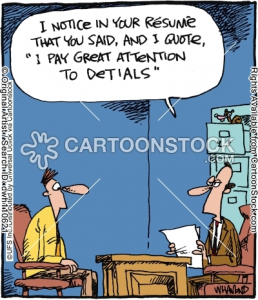
A résumé is a tool to introduce you to a future employer, graduate school admissions committee, service option, scholarship decision makers and more. Though the content can be similar in many sections, it will contain phrases and terms unique to each opportunity. Some of the words however can be more harmful then helpful. Reconsider using the terms or phrases below, regardless of the reason you created the résumé, due to possible misunderstanding, overuse, or risk of contradicting the message you are sending.

PROBLEM: A phrase that can regularly get you in trouble is Attention to detail. Many job and internship postings list out this skill set as one they are seeking, so it seems reasonable to include it on your résumé. The problem with indicating a strong attention to detail is if you have any mistake on your document, it contradicts the message you are sending. Common mistakes include lose/loose, inconsistent use of periods, adding extra spaces in between sections and switching dashes/hyphens.
SOLUTION: Alternatives to ‘attention to detail’ in your bullet point statements are the words precise, accurate, and focused; use these or other synonyms when accounting for your skills and accomplishments. Demonstrate your attention to detail v saying it.

PROBLEM: Another phrase not used on résumés is Responsible for. This phrase is common on the job description because it outlines the tasks you would be doing once hired. Keep in mind though that the reader reviewing your résumé doesn’t want to know what you were supposed to do; instead, they want to understand what you actually did.
SOLUTION: To demonstrate your knowledge, use action verbs to highlight your accomplishments and skills. In the Résumé, CV and Written Communication Guide, there is a list of alternative words and transferable skills.

PROBLEM: My least favorite word on a résumé is Assisted because that word does not usually accurately demonstrate your level of responsibility. It can be appropriate if you physically help people (in medical situations for example), but it is not the best choice when you could state what you actually did.
SOLUTION: Outlined below is a sample of a bullet point statement before is has been revised.
- Assisted manager with store displays {Ask yourself what does that mean? Depending on the tasks, there could be many responses.}
To make this bullet point statement stronger and have a better idea of what the person actually did, use the What/How/Why method from the Guide, which outlines how to edit the phrasing. The process how to build the bullet point statement from two to four stars.
First revision:
- Gave ideas to manager for store displays which brought in more foot traffic to store in a mall
Second revision:
- Offered ideas to manager about window displays to attract more teenagers to shop in the store
Next revision:
- Offered innovative suggestions about store window displays that are current to trends for 15-18 year old shoppers, the primary target audience for purchases
By the latest revision, the reader is clear on what the person did and that the individual may have some marketing knowledge. Stop by the Center for Career Development for a résumé or CV critique to make sure you are writing right.
